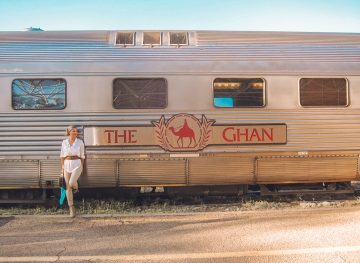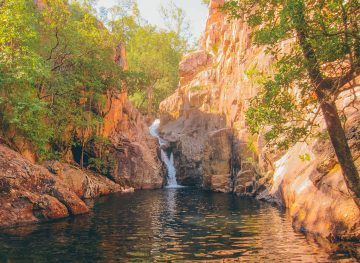
Hiking Kings Canyon is often an unexpected highlight for visitors of the Red Centre. While the National Park does not share the expectations of its more famous neighbor Uluru, I highly recommend adding it to your Australian Outback itinerary to experience the region in a whole new way.
Find out about my experience hiking Kings Canyon in Australia’s Outback!
![]()



Hiking Kings Canyon
The best way to see Kings Canyon is on foot. So grab those walking shoes and prepare yourself for a captivating 6-kilometer walk around the rim of the canyon.
It’s pretty flat for the most part though the initial steep ascent may seem a bit daunting.
The Canyon itself has no fences or railing around the rim so exercise caution at all times. Make sure you wear sunscreen and have enough water for the hike. Though 6km may not seem like a lot, with the scenery along the way you are bound to make a stop every so often (with the blazing sun overhead).
It’s a good idea to make your photo stops a rehydration session as well. While the rim walk is the most common and straightforward way of experiencing the canyon, there are many other walks available that vary in length and intensity.
There is even a wheel-chair friendly walk that takes you into the very heart of the canyon which is known as the Creek Walk. The 22km Giles Track Walk is more intense and often carried out overnight.
Be sure to make a visit to the sunset viewing deck for some of the most spectacular views and colors.

The best time to hike the Kings Canyon would be in the cooler months of the year which are from May to September. This period of the year has little rain, clear skies and most importantly, cooler temperatures.
If you do opt to go in the hotter months please be wary of the intense weather and prepare yourself in advance. It’s also better to hike early in the day and be down from the rim by around 10 A.M. to avoid the harshest sunlight.
![]()



About Kings Canyon
Kings Canyon is around 320 km from Alice Springs, the gateway to the Red Centre. The Canyon forms part of Watarrka National Park which is one of the major attractions in central Australia.
The national park has significance both locally and on an international level for its significant conservation area. It is believed that Watarrka National Park is home to over 600 different species of plants and native animals.
You may catch a glimpse of some on your way to the Kings Canyon. At a staggering 100 meters high, the flaming canyon walls overlook areas of dense vegetation.
Ferns and cycads occur most commonly. This outback oasis is referred to as The Garden of Eden and is a stark contrast to its dry surroundings.
You may even come across ghost gum which has a variety of uses for the locals. Another surprising feature is the gorgeous white sand around the area.

The canyon itself came into existence as a result of a compression of sand on a shallow inland sea. The Beehive Domes are also must-sees when hiking the canyon.
Weathering has shaped these domes over time and the result is stunning. Kathleen Springs, a shady waterhole, isn’t too far off either and offers great bird-watching potential.
It’s also worth noting that Kings Canyon is super absorbent, with its soft sandstone composition acting as a sponge after heavy rains. The sandstone then feeds the plants in the region, contributing to the luscious surrounds in a magical way.
There really is more than what meets the eye with this place.










Wow! I really enjoyed reading about Hiking King’s Canyon in Australia. I learned so much and I definitely want to visit there someday. Thanks for sharing. 🙂
We can’t wait to visit Kings Canyon and Uluru early next year. It looks like an absolutely amazing experience that we will remember forever!
Have an AMAZING time, Natalie!!